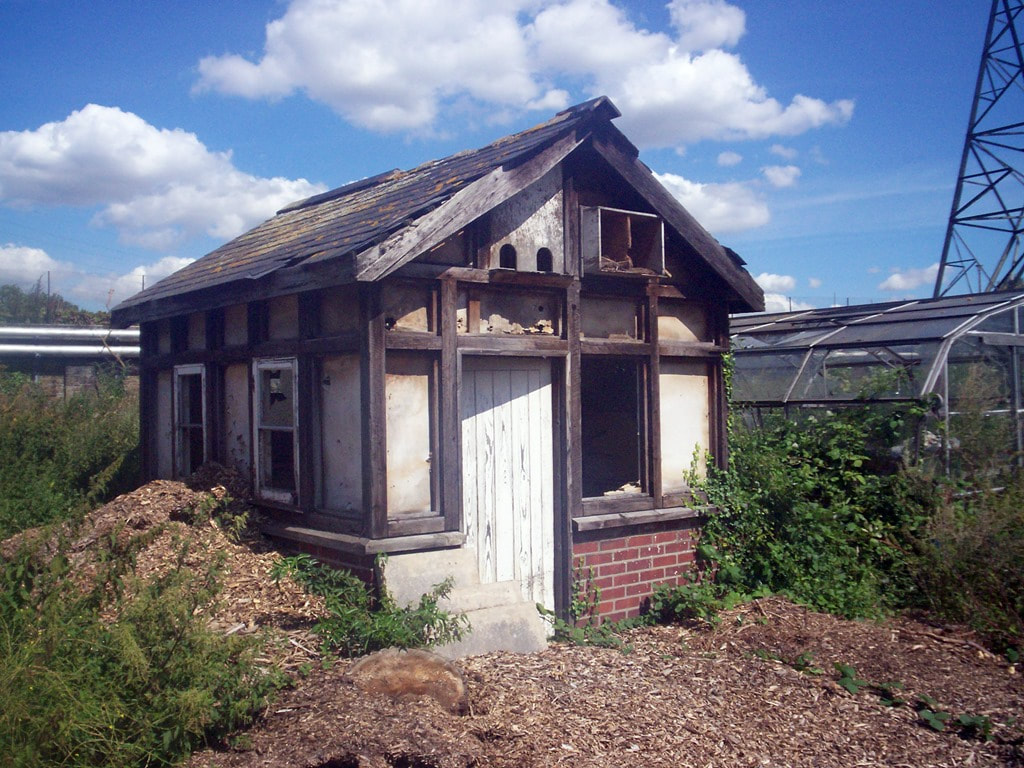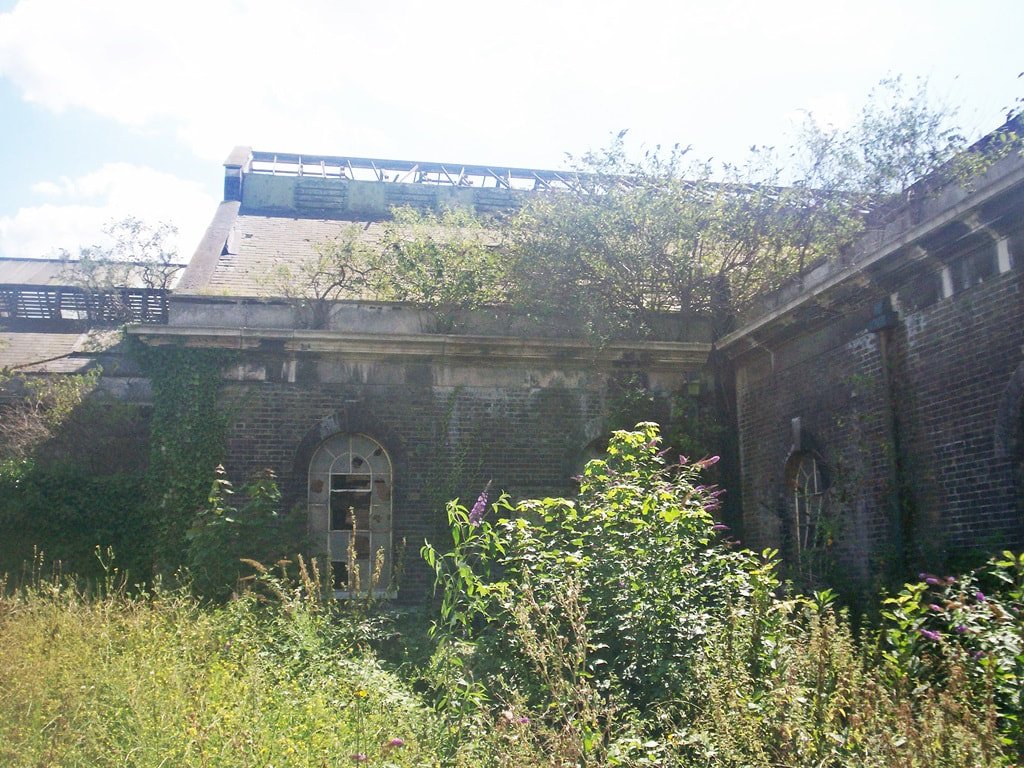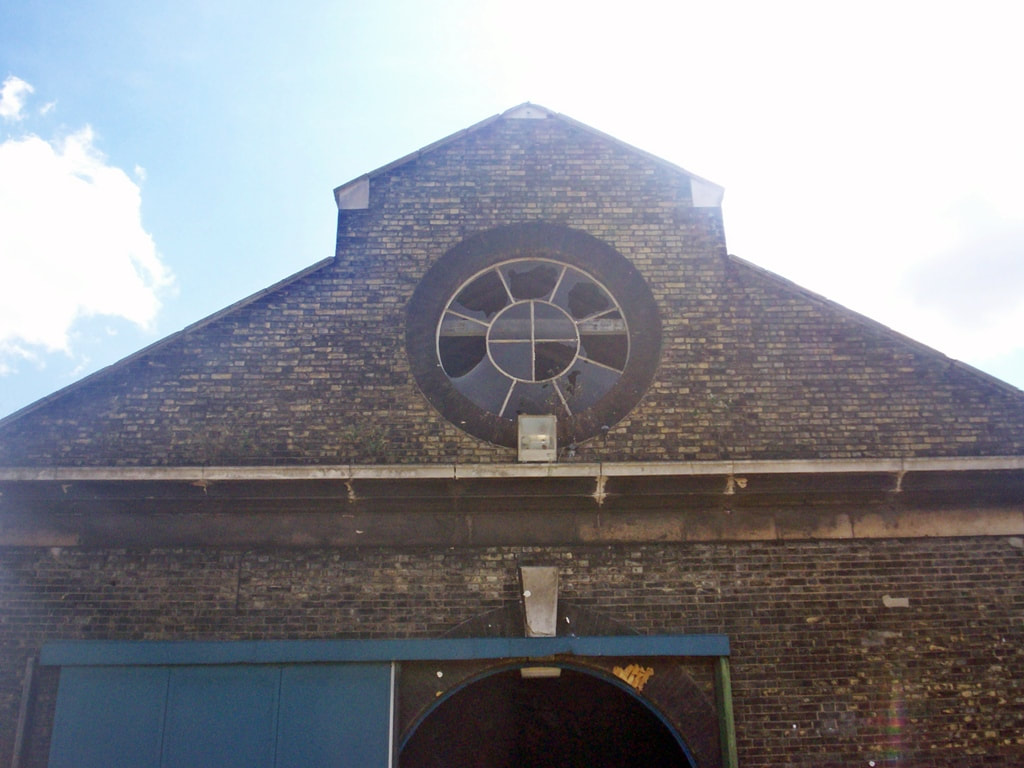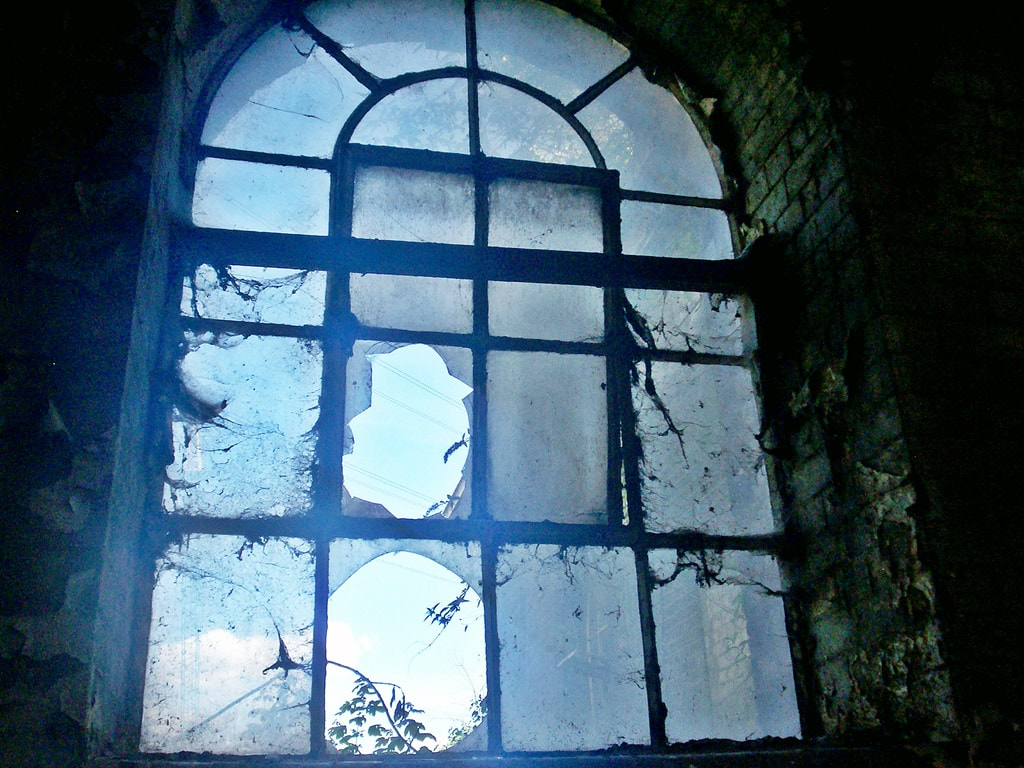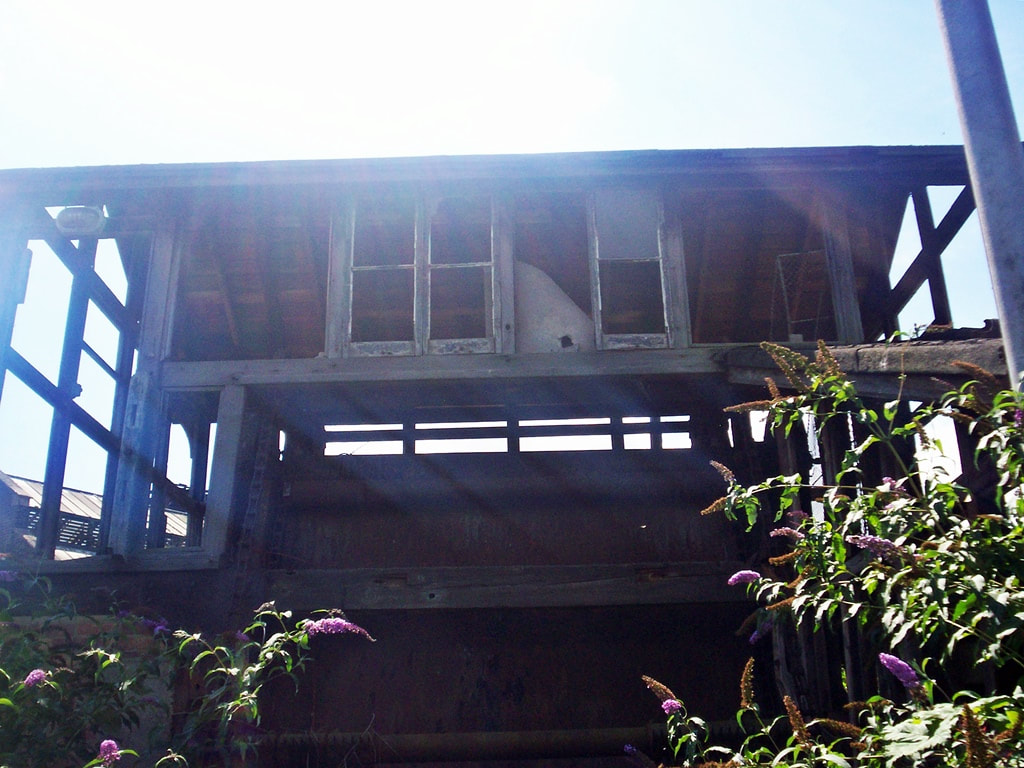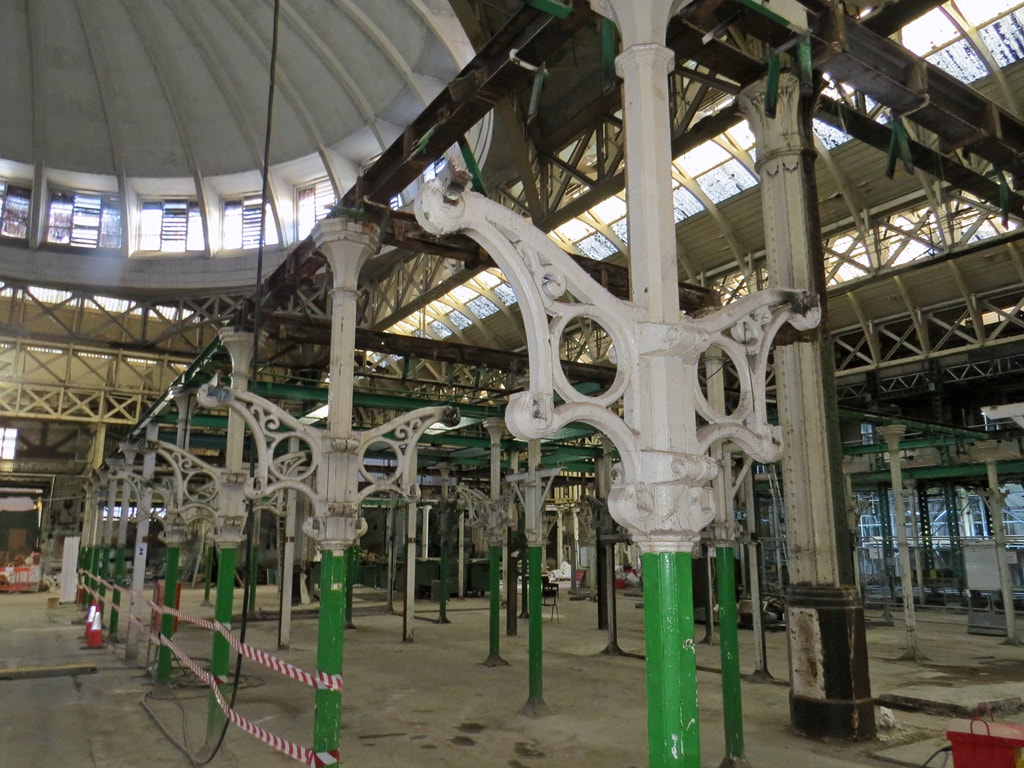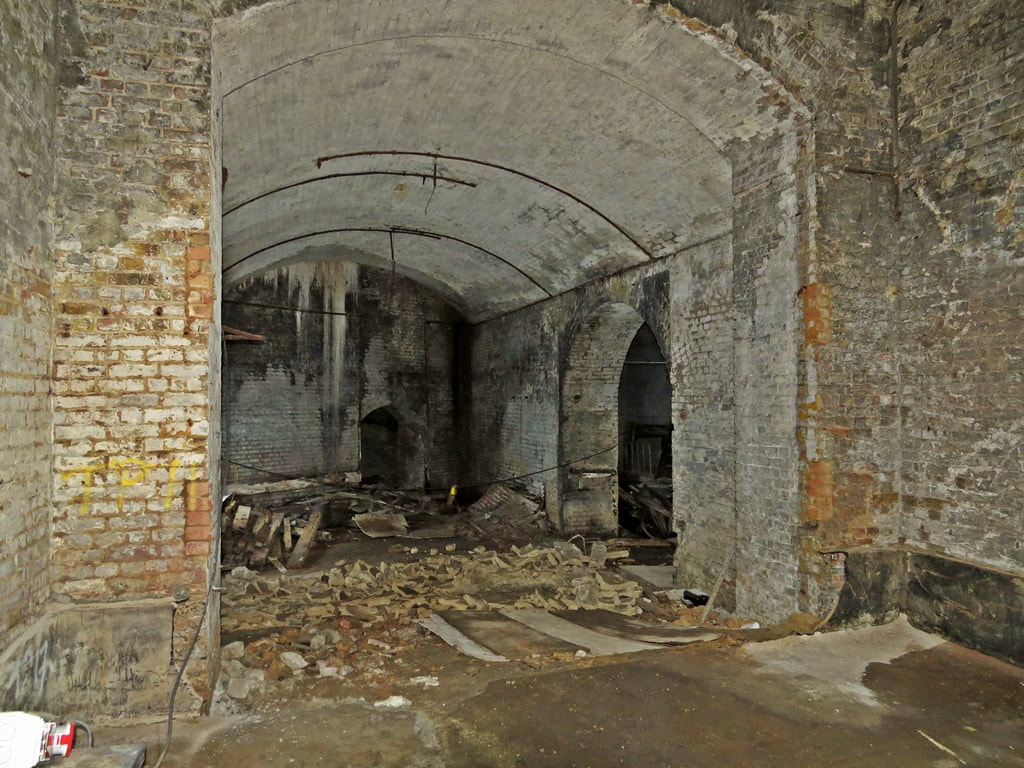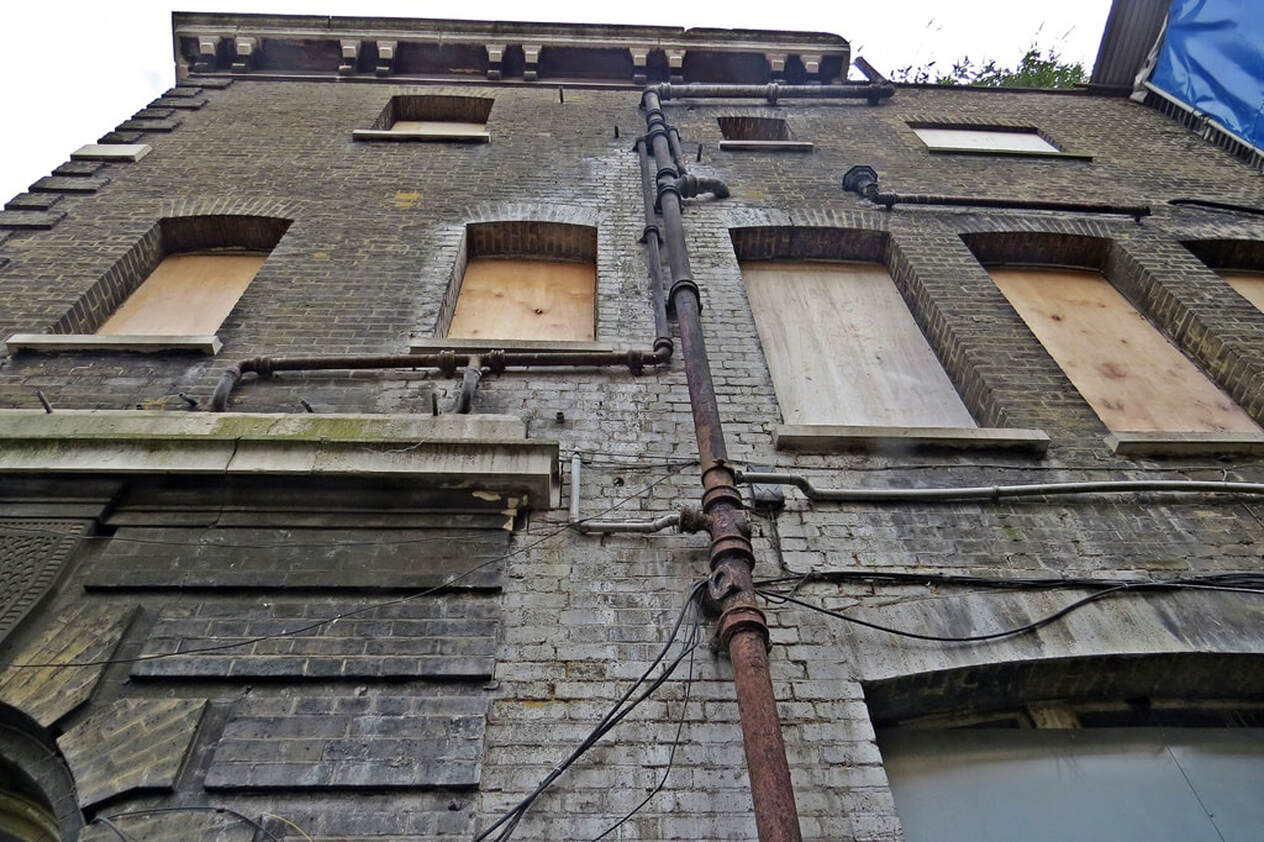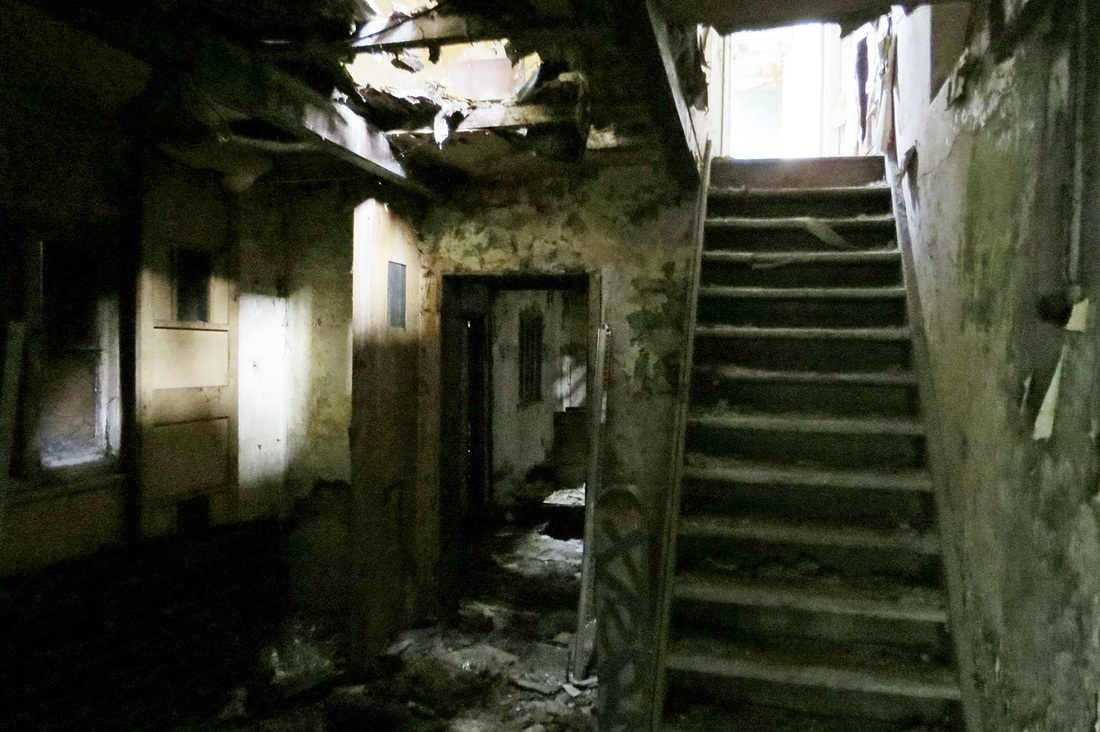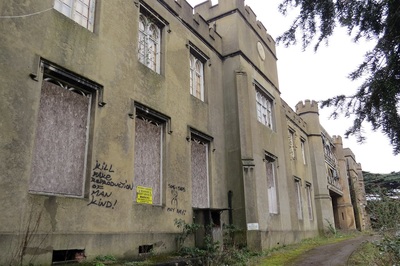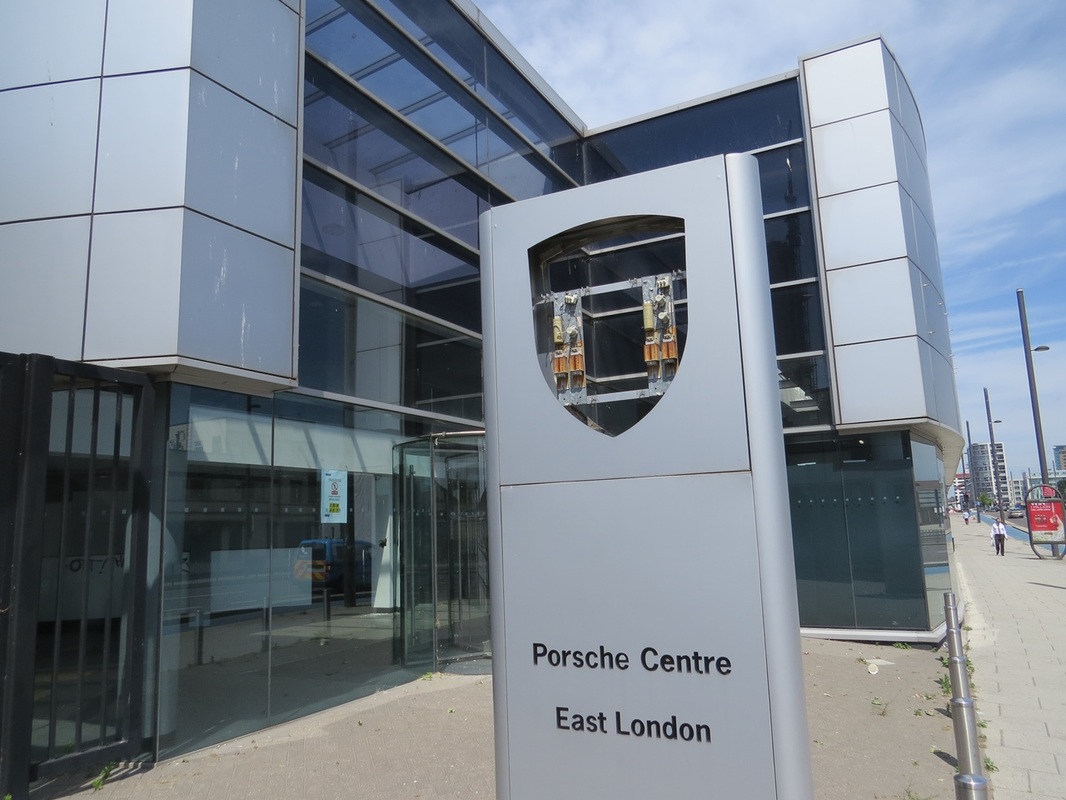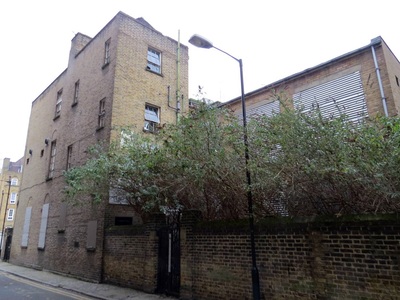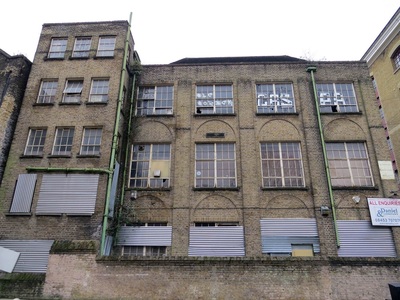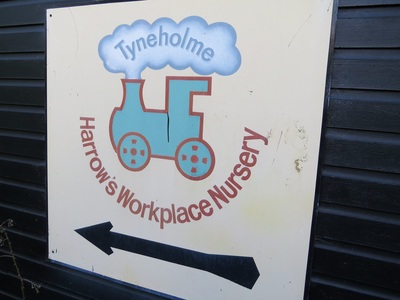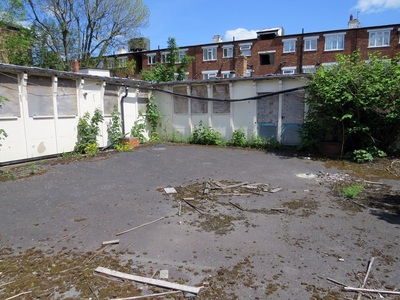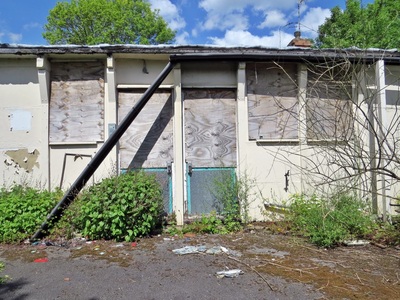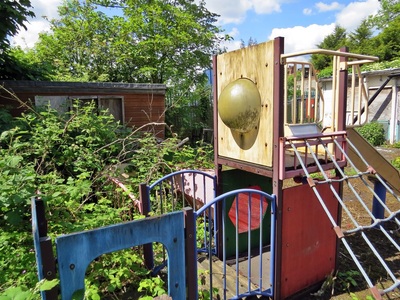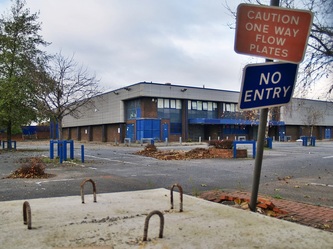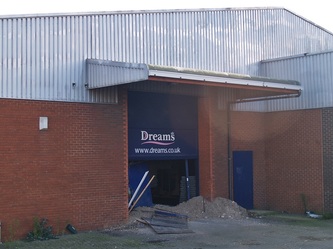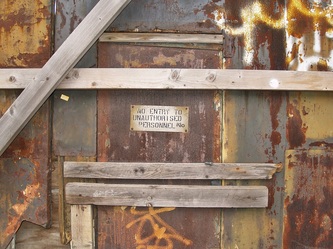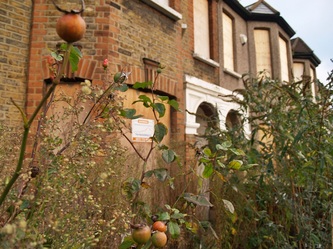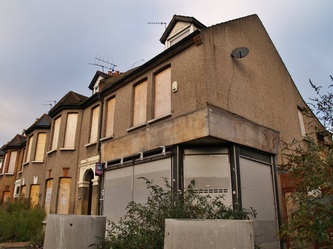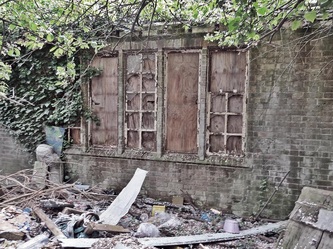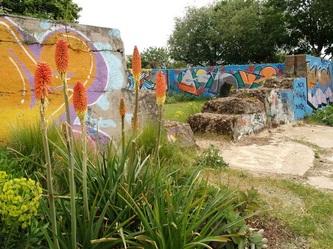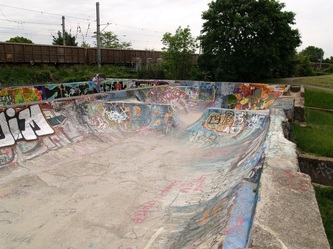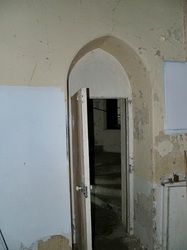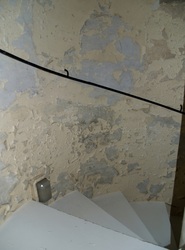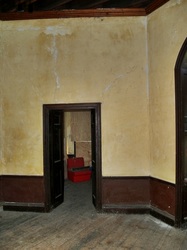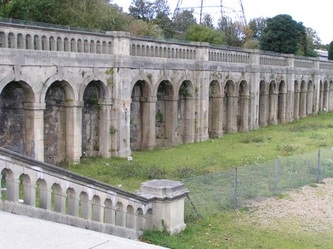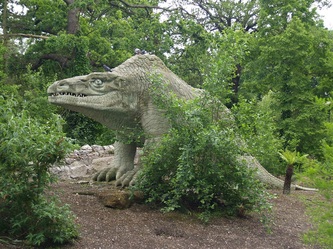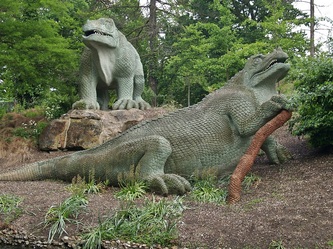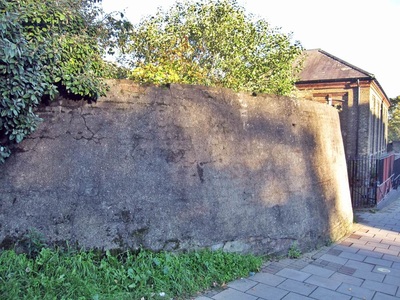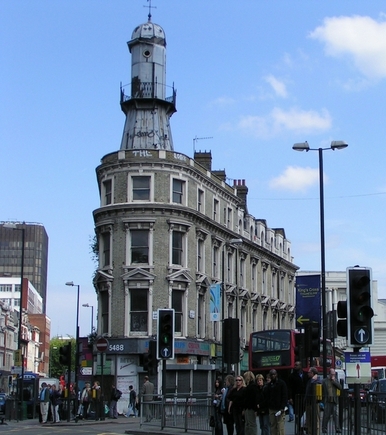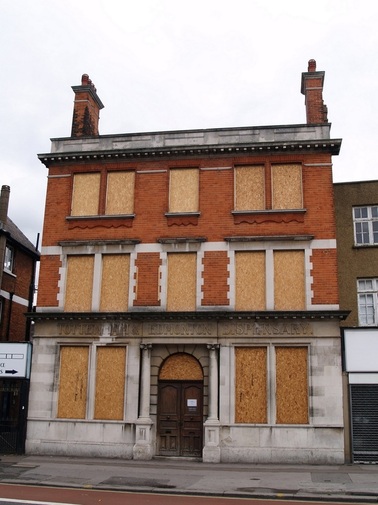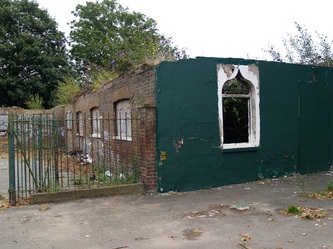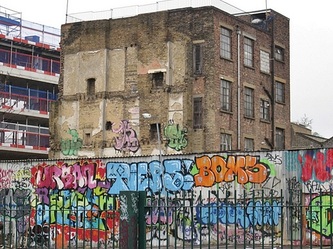Beckton Sewage Treatment Works - Barking, IG11
Beckton Sewage Treatment Works (actually situated just a few yards over the border in Barking) was formerly known as the Barking Sewage Works when built from 1864 onwards as part of Joseph Bazalgette's scheme to remove sewage from London by creating two large sewers from the capital, one on each side of the Thames and known as the Southern and Northern Outfall Sewers. It treats the waste water from the Northern Outfall Sewer serving North and East London. The plant has been extended and upgraded several times. The last of the Victorian buildings pictured here were demolished as part of an upgrade in 2011. Beckton remains an operational Thames Water site and according to the Tideway website (the company delivering a new 'super sewer') it is the largest sewage treatment works in Europe.
These rare shots were taken by Nathan Hume for Derelict London when he went to spray the Japanese knotweed in and around the site. Nathan sent these to me back in 2008, and they are many of the treasures sitting on my hard drive which I am gradually working my way through. I guess we shall never get to find out the story about the flipped car abandoned in the pit...
These rare shots were taken by Nathan Hume for Derelict London when he went to spray the Japanese knotweed in and around the site. Nathan sent these to me back in 2008, and they are many of the treasures sitting on my hard drive which I am gradually working my way through. I guess we shall never get to find out the story about the flipped car abandoned in the pit...
Smithfield General Market and Tunnels - Farringdon, EC1
Smithfield, originally known as Smoothfield, was, as its name suggests, once a large open space, famous for its horse market, and for jousting and sporting events – as well as public executions. It was also the site where one of the leaders of the Peasants’ Revolt, Wat Tyler, was killed in 1381. And since the early Middle Ages it has housed a livestock market.
Shown here is the General Market, originally built in 1883 to the designs of Sir Horace Jones. Bombed during the Blitz, causing 110 deaths, it was repaired in the 1950s plus construction of the dome pictured above, but most of it has been vacant since the 1980s. At the time of the first edition of the Derelict London book back in 2008 the future was bleak as the Market buildings faced demolition at the hands of developers who wanted to put office blocks here. Planning permission for demolition was refused and a later plan to gut out the interiors retaining just the facades were blocked by the Government after meeting opposition from heritage campaigners.
Positive news is that work has commenced to transform the buildings and the extensive basement areas into a museum for the Museum of London as part of a £337 million move here in 2024 from their Barbican site. The adjacent Central Market continues as a wholesale meat business, but there are plans to move it, along with New Spitalfields and Billingsgate to the redundant Barking Reach Power Station site in east London.
Shown here is the General Market, originally built in 1883 to the designs of Sir Horace Jones. Bombed during the Blitz, causing 110 deaths, it was repaired in the 1950s plus construction of the dome pictured above, but most of it has been vacant since the 1980s. At the time of the first edition of the Derelict London book back in 2008 the future was bleak as the Market buildings faced demolition at the hands of developers who wanted to put office blocks here. Planning permission for demolition was refused and a later plan to gut out the interiors retaining just the facades were blocked by the Government after meeting opposition from heritage campaigners.
Positive news is that work has commenced to transform the buildings and the extensive basement areas into a museum for the Museum of London as part of a £337 million move here in 2024 from their Barbican site. The adjacent Central Market continues as a wholesale meat business, but there are plans to move it, along with New Spitalfields and Billingsgate to the redundant Barking Reach Power Station site in east London.
Beneath Smithfield is an extensive complex of tunnels. These were used for underground stores and for railway sidings for delivery of meat to the market. During the Second World War, an underground cold store here was used for secret experiments on pykrete, a mixture of ice and wood pulp, believed to be tougher than steel and proposed to used in the construction floating airstrips in the Atlantic to allow refuelling of cargo planes. The project was abandoned after it became obsolete with the development of longer-range aircraft. There is still a live railway running through the tunnels, with Thameslink passing by the south-west corner of the site.
Until recent years part of the tunnels were used as an area to store salt for use on the City's street during icy weather. During recent preparatory work on the site for Museum of London (see General Market, above) many bricked up vaults and cellars were discovered containing numerous rats.
Until recent years part of the tunnels were used as an area to store salt for use on the City's street during icy weather. During recent preparatory work on the site for Museum of London (see General Market, above) many bricked up vaults and cellars were discovered containing numerous rats.
Safa House (The Stone Institute) - Deptford SE14
Among all the new build flats around this part of Deptford on Arklow Road is piece of local industrial heritage - an old Victorian social centre for the adjacent Stone's foundry (all gone now) which had nearly 700 employees. This building contained a concert room and gymnasium, a library, a coffee tavern and two dining rooms. Workers from Stone's Deptford foundry established the Stone Rowing Club in 1923, but after the company refused a grant to purchase new equipment, the club broke away from the works and set up independently which has evolved into the current Globe Rowing Club in Greenwich. Stone & Co was a British marine and railway engineering company for the manufacture of nails and rivets. The Deptford factory closed in 1969, but production continues to operate in Charlton though are due to close down soon after selling off their land to developers for the building of 1500 flats.
I first photographed this dilapidated building back in 2003 which has been used as a squat with the occasional rave and a lock-up over the years, but current proposals are to convert the building to provide over a dozen residential flats.
I first photographed this dilapidated building back in 2003 which has been used as a squat with the occasional rave and a lock-up over the years, but current proposals are to convert the building to provide over a dozen residential flats.
West Ham Magistrates Court - Stratford, E15
Built in 1884 and closed exactly 100 years later. This Grade II-listed courthouse owned by Newham Council has deteriorated significantly since closure.
An arson attack in 2013 gutted a courtroom and destroyed upper floors resulting in emergency conservation work such as scaffolding & a temporary roof to prevent further decay to the buildings. Renovation works have now commenced with the building to be used as a 'community asset' once completed.
After a gig at the ABC in Romford in 1965, The Rolling Stones were on their way home when they stopped at a petrol station in Romford Rd, Forest Gate for a toilet break. The attendant didn't like the look of them, so he refused to let them use his loo and told them to clear off. They then started to swear and replied, "We'll piss anywhere man!" and urinated up his wall. This resulted in Jones, Jagger and Wyman appearing at West Ham Magistrates Court when they were fined £5 each for insulting behaviour. Mick returned to Stratford 53 years later when the Stones played a concert at the London Stadium.
An arson attack in 2013 gutted a courtroom and destroyed upper floors resulting in emergency conservation work such as scaffolding & a temporary roof to prevent further decay to the buildings. Renovation works have now commenced with the building to be used as a 'community asset' once completed.
After a gig at the ABC in Romford in 1965, The Rolling Stones were on their way home when they stopped at a petrol station in Romford Rd, Forest Gate for a toilet break. The attendant didn't like the look of them, so he refused to let them use his loo and told them to clear off. They then started to swear and replied, "We'll piss anywhere man!" and urinated up his wall. This resulted in Jones, Jagger and Wyman appearing at West Ham Magistrates Court when they were fined £5 each for insulting behaviour. Mick returned to Stratford 53 years later when the Stones played a concert at the London Stadium.
Twyford Abbey - West Twyford, Ealing, NW10Never actually an abbey..... Thousands drive past on the nearby North Circular every day not knowing there is this great building crumbling away so close by. The access is via Twyford Abbey Road where various security warning signs greet you at the entrance gates. Moving along the road you can make out the abandoned building in the distance across a stretch of overgrown lawns. I first spotted this building in 2002, and I had forgotten about it and when someone mentioned it recently I was surprised that the site hadn't been redeveloped so decided to take another look. Situated near Hangar Lane gyratory in the only corner of Ealing with a NW postcode this was the site of the West Twyford manor house. The manor house was partially demolished around 1715 and in 1806 the manor house a stagecoach proprietor turned the house into a Gothic-style mansion with an extension around the original house infilled a genuine medieval moat and renamed it Twyford Abbey and being the only building in the area, the name Twyford Abbey was applied to the whole of West Twyford. In 1902, the Abbey was bought by the Alexian Brothers, a Roman Catholic order who set up a nursing home there. The Alexian Brothers enlarged and changed the house several times. In 1988, due to changes in rules and regulations of running nursing homes and the costs associated with adaptations, the brothers who were short of funds closed the home & joined another part of their order in Manchester. The abbey, which is a Grade II listed building, now lies derelict and its on English Heritage’s ‘Buildings at Risk’ register where, not surprisingly, its condition officially described as ‘poor’. The interior is in an extremely dangerous condition and casual entering is not advised (or permitted) with much water damage, rotten floors, etc. Various outbuildings including one that probably served as a caretaker/gardener's cottage are also in poor condition. All these pics were taken in Spring 2016. |
WINTER 2017 UPDATE: The owners say the site is now under development. "It is a private property, extremely dangerous, structurally un-stable and easily poses real risks to anyone trying to explore it without a chaperone.Anyone entering the property by breaking over our fences will be prosecuted- as owners of the site WE are liable if any harm comes to any one trying to access the building without us knowing- if we don't know if some one is there we can't protect them and I would really appreciate it if you could assist us in keeping readers of your site safe by making them aware of the real dangers and liabilities".
Various planning applications have been made but not granted. These have been hindered by Department of Transport objections to developers’ plans for road access, land designated Metropolitan Open Land with the grounds having Site of Special Scientific Interest status and all the trees being covered by a tree preservation order.
Harwich House Remains - Pedley Street Arches E1
|
On a stretch of no-mans land (for the moment at least, before the luxury apartments go up) on the border between Shoreditch and Bethnal Green is this disused railway arch as seen in films such as Lock, Stock and Two Smoking Barrels and gritty TV drams such as Luther and Whitechapel. Between the disused arch and railway tracks still in use are some interesting ornamental structures glimpsed when travelling past on the train when travelling to Liverpool Street. This 'graveyard' tucked away behind secure fencing, hence difficult to photograph, is architectural salvage from a building called Harwich House part of the Liverpool Street Station complex opposite Hamilton Hall that was demolished when the Station was restored and extended in the late 80s/early 90s. Harwich House housed the department that was responsible for British Rail ferries that operated from Harwich. Above the war memorial in the current Liverpool St Station there is a long stone Great Eastern Railway plaque which was also was salvaged from Harwich House. |
Porsche Showroom - Stratford High Street
Alot has changed in the area since this showroom arrived in Stratford in the early 2000s. Now situated next to the Olympic Park and close to Westfield it is to be demolished to make way for flats of up to 18 storeys plus some new commercial space. The car dealership moved out to near a new purpose-built showroom out in the wilderness adjacent to Gallions Reach DLR in April 2015.
St Patricks Social Club - Wapping, E1Situated on Dundee Street (previously known as Upper Well Alley). The site was previously houses and the present building was previously used by St Patricks School Club and finally St Patricks Social Club which closed down a few years ago among various planning proposals which have not come into fruition. I had a few good nights at the Social Club myself and its closure was a sad loss. The main hall & bar area had some old photos of local dockers, beanos to the seaside, local amateur football teams & even one of Norman Wisdom who once visited the club! Meanwhile, the building has been left to rot with roof damage meaning that the building might end up getting demolished. Current owners are the Westminster Roman Catholic Diocese Trustee, who are also owners of nearby St Patrick’s church. |
Chingford Mill Pumping Station - Chingford, E4In 1873, the East London Waterworks Company acquired an ancient water mill that was recorded in Domesday. The mill was demolished and in 1895 this red brick pumping station was built. It is over a well (at a depth of 141 feet) in the chalk and a steam engine pumped drinking water from a borehole. Planning permission was granted in 2005 to turn the building into homes, but this lapsed due to inactivity over the years. The occupiers carried out works which were not authorised & local enforcement officers were denied entry which resulted in a police raid late last year and someone was arrested with various charges including planning violations, fly-tipping and unlawful business operations. Nearby residents have also alleged anti-social behaviour from people associated with this site. As of 2018, the site is undergoing conversion. |
Harrow, HA1 - Disused Nursery/Pre-School unit
I stumbled upon this by complete accident. After looking at the site of the long gone Railway Hotel by Harrow & Wealdstone Station I headed off past the Crown Court to find the source of Yeading Brook and saw this overgrown driveway up the side of a (still functioning) family planning clinic. Upon closer investigation there are two sets of derelict buildings -the large wooden hut of the Tyneholme Nursery and the prefabs of (presumably) the Headstone Centre, a pre school language centre plus a very overgrown abandoned children's playground
CHARLTON SE7 - WOOLWICH ROAD

There were once many factories in this area between Woolwich Road and the River Thames - Johnson & Phillips, British Ropes, Harvey’s, Stone Manganese & Siemens. Many of these suffered heavy bombing in 1940-41. The Charlton (Greyhound) Stadium was also here until 1970 (see London's Long Lost Sports Grounds elsewhere on this website). During the 1980s Charlton was an early pioneer in the out of town retail parks which now lurk on the outskirts of every UK town. This area hosted soulless large prefab retail units such as Queensway furnishings and Harris Carpets, but these have either been demolished or lay derelict. Whilst the building on old brownfield sites and the replacement of the old retail units with new ones might not be too controversial it will be sad to see a Victorian terrace demolished.
This large area will be new retail space with large stores such as Marks & Spencers and a budget hotel chain as part of a wider scheme branded by planners as Charlton Riverside. "By 2027, Charlton Riverside will be transformed into a new urban quarter connecting Greenwich Peninsula to Woolwich town centre. It will comprise a sustainable mix of uses including substantial residential use in a high-quality environment focussed around an enhanced Thames Barrier Park. There will be a thriving education and creative industries hub in the eastern Historical Quarter surrounded by a mix of high quality, residential led uses including high quality business space."
This large area will be new retail space with large stores such as Marks & Spencers and a budget hotel chain as part of a wider scheme branded by planners as Charlton Riverside. "By 2027, Charlton Riverside will be transformed into a new urban quarter connecting Greenwich Peninsula to Woolwich town centre. It will comprise a sustainable mix of uses including substantial residential use in a high-quality environment focussed around an enhanced Thames Barrier Park. There will be a thriving education and creative industries hub in the eastern Historical Quarter surrounded by a mix of high quality, residential led uses including high quality business space."
Harveys of Charlton
GA Harvey & Co founded in 1874 was a metal fabrication factory. The impressive factory entrance dominated the end of a small side road called Holmwood Villas where remnants of its facade can still be seen retained to form part of a security fence around the old site.
The business started in an old forge in Lewisham making cisterns & guttering for local builders but within 10 years was supplying nationally. They then began to specialise in metal perforations such as making perforated zinc for meat safes. They moved to this Charlton site in 1913 which had a railway branch line into the works.
By the 1930s the company produced all kinds of metal perforation, manufacture of dustbins and major industrial pressure vessels. They also moved into metal office furniture for which they became famous. King George VI once visited for a tour of the factory. Harvey's had its sports club & ground and also owned many properties around Greenwich & Woolwich, which were rented to employees. The main estate was Harvey Gardens, alongside The Valley in Charlton.
The factory was demolished in or around 1990 and Morrison Utilities are now using it as storage yard for water main replacement work. Long-term prospects are to build retail units here as part of the Charlton Riverside project.
The business started in an old forge in Lewisham making cisterns & guttering for local builders but within 10 years was supplying nationally. They then began to specialise in metal perforations such as making perforated zinc for meat safes. They moved to this Charlton site in 1913 which had a railway branch line into the works.
By the 1930s the company produced all kinds of metal perforation, manufacture of dustbins and major industrial pressure vessels. They also moved into metal office furniture for which they became famous. King George VI once visited for a tour of the factory. Harvey's had its sports club & ground and also owned many properties around Greenwich & Woolwich, which were rented to employees. The main estate was Harvey Gardens, alongside The Valley in Charlton.
The factory was demolished in or around 1990 and Morrison Utilities are now using it as storage yard for water main replacement work. Long-term prospects are to build retail units here as part of the Charlton Riverside project.
The terrace dates from around 1890 and was originally accompanied by numerous similar terraced houses along the north side of Woolwich Road. A heritage report by the council concluded that: "The buildings do not hold any artistic, archaeological or communal interest or value. They represent part of the late Victorian expansion of this area of Charlton but are common in style, architectural detailing and composition to innumerable late 19th century speculative suburban houses and developments throughout London and throughout the country."
PALMERS GREEN, N13 - DHSS BUILDING
I've wondered about this building for years obscured by advertising hoardings on the A406 North Circular road between a filling station and the Clockhouse crossroads. It's not really that easy to notice at all if you are driving or even walking by on the pavement. After closer investigation it's an interesting interior, but I was non the wiser as to what the building originally was or any plans to redevelop it.
I assumed that it was some sort of old workshop but how wrong I was.... It turns out, thanks to a response from people who saw this on the Facebook page, that it was a labour exchange & benefits office built between 1914 and 1935 and closed in the late 1980s. The building was a squat for a while afterwards.
Gary C writes: "it was once a DHSS dole office where I used to sign on in 1980, I think before that it was a labour exchange, it used to have a clock tower on it, hence the name of the shops next to it, (Clock House Parade), I'm also sure in the 1970s people waiting for charabanc trips to Margate and beyond used to sit on seats outside, I might be wrong on the last bit as I was only about 8 years old at the time. Hope this helps, (PS, I only signed on for 6 months, I’ve worked ever since, lol)"
Paul O'C writes: "It was a real 'old school' dole office as well , all the chairs were nailed down and there were security screens up at the counter. This was back when people who signed on were 'unemployed' rather than 'jobseekers'!"
I assumed that it was some sort of old workshop but how wrong I was.... It turns out, thanks to a response from people who saw this on the Facebook page, that it was a labour exchange & benefits office built between 1914 and 1935 and closed in the late 1980s. The building was a squat for a while afterwards.
Gary C writes: "it was once a DHSS dole office where I used to sign on in 1980, I think before that it was a labour exchange, it used to have a clock tower on it, hence the name of the shops next to it, (Clock House Parade), I'm also sure in the 1970s people waiting for charabanc trips to Margate and beyond used to sit on seats outside, I might be wrong on the last bit as I was only about 8 years old at the time. Hope this helps, (PS, I only signed on for 6 months, I’ve worked ever since, lol)"
Paul O'C writes: "It was a real 'old school' dole office as well , all the chairs were nailed down and there were security screens up at the counter. This was back when people who signed on were 'unemployed' rather than 'jobseekers'!"
TOTTENHAM AND WOOD GREEN SEWAGE WORKS
Opened in 1864 in Tottenham Hale. Sewerage was the worst problem arising from Tottenham's mid-19th-century expansion. In 1843, the riverside lands were generally malarial and by 1848 some 800 houses discharged their waste into the local Moselle Brook alone.
In 1964,the works were closed. The site was levelled, apart from the engine house building which is now a cafe & museum and the settling tanks and filter beds which are now a skateboard park and gardens.
In 1964,the works were closed. The site was levelled, apart from the engine house building which is now a cafe & museum and the settling tanks and filter beds which are now a skateboard park and gardens.
SYDENHAM HILL WOOD SE21 - VICTORIAN FOLLY
Sydenham Hill Wood forms the largest remaining tract of the old Great North Wood, which once stretched from Deptford to Selhurst. In the 1870s large Victorian villas with extensive gardens were established on Sydenham Hill, and the wood is now a wonderful mix of old and new woodland, Victorian garden survivors and even the remains of a Victorian folly (shown below). It is also home to over 200 species of trees and flowering plants, including wild garlic, early dog violet and bugle, not to mention various fungi, rare insects, birds and woodland mammals.
SHOOTERS HILL SE18 - SEVERNDROOG CASTLE

This triangular-shaped 60-foot tall castle is the focal point of what was formerly a popular recreation area. It was built in 1784 by Lady James of Eltham as a memorial to her husband, Sir William James, and named after his most famous exploit when, in 1755, he destroyed the fleet and stronghold of pirates at Severndroog Island on the Malabar coast of India.
In 1922 Severndroog Castle and the surrounding woodland was bought by the London County Council to form a recreational area for Londoners. A small teashop on the ground floor of the castle proved enormously popular in the postwar years. Greenwich Council then took over ownership, but decided that it did not have the resources to maintain the building. The castle and tea-shop closed and were boarded up in 1988. Since then, the building has been subject to vandalism and decay. A proposal to lease the castle to a property developer, who intended to convert it into offices, was met with furious opposition from campaigners. The Severndroog Castle Building Preservation Trust has since beeen created to restore the building and open it to the public. The SCBPT has been working with the local community to secure funding to restore Severndroog Castle. The Trust aims once again to ensure full public access to Severndroog and is working with architects to design a multifunctional, secure building with a viable future at the heart of the community. Future uses under SCBPT management could include; hire for weddings, receptions and meetings, a woodland interpretation centre, an exhibition on the history of the castle, a franchised café/tearoom, and a viewing platform for the magnificent views over London.
People passing by a certain spot on Shooters Hill in the 1830s reported hearing strange sounds and also occasionally seeing the figure of a woman dressed in white, who was seen gliding around the area. Although the reports were numerous, they were not believed at the time. However, in January 1844, a labourer working in the allegedly haunted area unearthed a skeleton, and it was thought that from the terrible fracture to her skull that she had been the victim of foul play. She had obviously not been dead for very long because there was still a large amount of braided hair attached to her skull. There was no means of identifying the skeleton and the remains were buried in the local churchyard. It was in 1881 that there was thought to be a connection between the White Lady and the Old Bull Hotel, which stood not far from the site of the hauntings. When the Bull was being demolished an old pistol was found in the cellars, and it is thought that the damage to the White Lady’s skull was caused by the butt of the pistol. People passing by the haunted spot can still hear the poor woman’s last cries for help as she was viciously attacked and left to die.
SYDENHAM - CRYSTAL PALACE

The Crystal Palace had been the centrepiece of the Great Exhibition of 1851 in Hyde Park: an international wonder and a triumph of technology and the ingenuity of its designer, Joseph Paxton.
The Palace’s relocation from Hyde Park made this SE London’s major cultural and entertainment centre. This sparked a flurry of development, with new transport connections, jobs, housing and churches. The vast new Palace dominated the tree-lined ridge and was visible from all over London and beyond. It contained arts and architecture from Ancient Egypt to the renaissance, and exhibits from industry and the natural world. It also hosted concerts and circuses. For more than 80 years, the Crystal Palace and its park provided a focus and identity for the area that took its name.
In 1936, most of the Crystal Palace was destroyed in the country’s biggest peacetime fire of the 20th century. During World War II the 20-acre hilltop site was used as a dump for bomb site rubble.
Crystal Palace’s slow decay is evident everywhere. Surviving remnants of the building are now disappearing in the undergrowth. Only the terraces with their crumbling sphinxes are there to remind visitors of former glories. What was once the world’s largest marine aquarium also limps on. The Aquarium was opened in 1871 and salt water was brought all the way from Brighton by train. Tastes change and by the 1890s it had been transformed into a menagerie of monkeys who occupied the empty fish tanks. The Aquarium survived the 1936 fire but was destroyed when the North Tower was demolished in 1941. The Crystal Palace Dinosaurs, built in the 1850s were the first, ever, life-size dinosaur models in the world pre-dating the publication of Charles Darwin's Origin of Species by six years. The models themselves are now considered out of date and by and large inaccurate.
It somehow seems appropriate that one of Crystal Palace’s more bizarre claims to fame should also involve misfortune – it was the setting for the world’s first road fatality. In 1896, 44-year-old mother Bridget Driscoll, who had come to London with her teenage daughter and a friend to watch a dancing display, was hit, while walking on a terrace at Crystal Palace, by a car travelling at ‘tremendous speed’ (the driver was reported to be doing 4 mph). At the inquest, the coroner said: ‘This must never happen again.’
The Palace’s relocation from Hyde Park made this SE London’s major cultural and entertainment centre. This sparked a flurry of development, with new transport connections, jobs, housing and churches. The vast new Palace dominated the tree-lined ridge and was visible from all over London and beyond. It contained arts and architecture from Ancient Egypt to the renaissance, and exhibits from industry and the natural world. It also hosted concerts and circuses. For more than 80 years, the Crystal Palace and its park provided a focus and identity for the area that took its name.
In 1936, most of the Crystal Palace was destroyed in the country’s biggest peacetime fire of the 20th century. During World War II the 20-acre hilltop site was used as a dump for bomb site rubble.
Crystal Palace’s slow decay is evident everywhere. Surviving remnants of the building are now disappearing in the undergrowth. Only the terraces with their crumbling sphinxes are there to remind visitors of former glories. What was once the world’s largest marine aquarium also limps on. The Aquarium was opened in 1871 and salt water was brought all the way from Brighton by train. Tastes change and by the 1890s it had been transformed into a menagerie of monkeys who occupied the empty fish tanks. The Aquarium survived the 1936 fire but was destroyed when the North Tower was demolished in 1941. The Crystal Palace Dinosaurs, built in the 1850s were the first, ever, life-size dinosaur models in the world pre-dating the publication of Charles Darwin's Origin of Species by six years. The models themselves are now considered out of date and by and large inaccurate.
It somehow seems appropriate that one of Crystal Palace’s more bizarre claims to fame should also involve misfortune – it was the setting for the world’s first road fatality. In 1896, 44-year-old mother Bridget Driscoll, who had come to London with her teenage daughter and a friend to watch a dancing display, was hit, while walking on a terrace at Crystal Palace, by a car travelling at ‘tremendous speed’ (the driver was reported to be doing 4 mph). At the inquest, the coroner said: ‘This must never happen again.’
CRYSTAL PALACE SE19 - RUINS OF BRUNEL'S WATERTOWER
Thousands of gallons of water were needed to feed the fountains and cascades abounding in the Crystal Palace Park. Water towers were constructed, but the weight of water in the raised tanks caused them to collapse. Isambard Kingdom Brunel was consulted and came up with plans for two 280ft high towers, one at the north end of the building and one at the south.
By the turn of the century, the Palace was losing money and declared bankruptcy in 1911. The fountains were turned off, and Brunel's huge water towers emptied. So, when the building caught fire in 1936, there was no water on hand to put out the blaze and the Crystal Palace was destroyed. All that was left standing after the 1936 fire were the two water towers. The south tower (pictured here) was taken down shortly after the fire, as the damage sustained presented a major risk to houses nearby. The brickwork around the entrance of the South Tower and the main valves which took water to the fountains down in the Park are still visible. A network of 10 miles of piping for the waterworks was concealed underground.
The other tower was demolished with explosives in 1941 as it would have provided a landmark for WWII German aircraft & by then the grounds were used as a secret manufacturing base for aircraft radar screens and other hi-tech equipment of the time.
Another point of interest - In the early 1930s, John Logie Baird, inventor of the world's first television, transmitted early television pictures from the south Water Tower!
By the turn of the century, the Palace was losing money and declared bankruptcy in 1911. The fountains were turned off, and Brunel's huge water towers emptied. So, when the building caught fire in 1936, there was no water on hand to put out the blaze and the Crystal Palace was destroyed. All that was left standing after the 1936 fire were the two water towers. The south tower (pictured here) was taken down shortly after the fire, as the damage sustained presented a major risk to houses nearby. The brickwork around the entrance of the South Tower and the main valves which took water to the fountains down in the Park are still visible. A network of 10 miles of piping for the waterworks was concealed underground.
The other tower was demolished with explosives in 1941 as it would have provided a landmark for WWII German aircraft & by then the grounds were used as a secret manufacturing base for aircraft radar screens and other hi-tech equipment of the time.
Another point of interest - In the early 1930s, John Logie Baird, inventor of the world's first television, transmitted early television pictures from the south Water Tower!
KINGS CROSS - THE LIGHTHOUSE BUILDING
This building was constructed in 1875 and the ‘lighthouse’ on the top is something of an enigma. Some claim that it dates back to the time when oysters were popular and cheap fast food and the ‘oyster houses’ that sold them were marked with a lighthouse. Some claim that the ‘lighthouse’ is really an old helter-skelter ride from a fairground. No one, though, seems sure.
This whole area is getting a facelift now that the international railway station is over the road at St Pancras station, and the plan is to redevelop the Lighthouse Building as office, retail and food and drink outlets.
Sara writes: "this lovely building was squatted by some dubious friends and i moved in after being evicted from another property at short notice. Most of the buildings had fallen into serious disrepair and were not really habitable (missing floors and staircases, no water etc). One night, whilst on the roof behind the old garage buildings towards the rear of the complex, we discovered a light well with missing panes. We tied a rope to the railings and lowered ourselves down into the room below, in which we found a set of stairs leading down. Following these for a while, we eventually emerged onto an old tube station platform! the line was still in use, but this particular secret stop was not. There is a workmans entry to it on the end that backs on to the Scala, however I don't think that has been accessed in a long time either."
David Wright writes: "Forty years ago,I was Manager of the Boots at Kings Cross;which is now the left hand half of Ladbrokes. I was told, then, that the "lighthouse" had been a watch tower for spotting body snatchers in St.Pancras Graveyard, which, from its size, position and windows,made sense."
This whole area is getting a facelift now that the international railway station is over the road at St Pancras station, and the plan is to redevelop the Lighthouse Building as office, retail and food and drink outlets.
Sara writes: "this lovely building was squatted by some dubious friends and i moved in after being evicted from another property at short notice. Most of the buildings had fallen into serious disrepair and were not really habitable (missing floors and staircases, no water etc). One night, whilst on the roof behind the old garage buildings towards the rear of the complex, we discovered a light well with missing panes. We tied a rope to the railings and lowered ourselves down into the room below, in which we found a set of stairs leading down. Following these for a while, we eventually emerged onto an old tube station platform! the line was still in use, but this particular secret stop was not. There is a workmans entry to it on the end that backs on to the Scala, however I don't think that has been accessed in a long time either."
David Wright writes: "Forty years ago,I was Manager of the Boots at Kings Cross;which is now the left hand half of Ladbrokes. I was told, then, that the "lighthouse" had been a watch tower for spotting body snatchers in St.Pancras Graveyard, which, from its size, position and windows,made sense."
DERELICT LONDON GARAGES
By Clicking on the Amazon link Derelict London receives a small % of anything that you spend! hint hint....
TOTTENHAM N17 - TOTTENHAM AND EDMONTON DISPENSARY
This dispensary was opened in 1864 to provide the poor with medical advice and medicine. It was run by a committee, chaired by the local vicar. The services provided were free at first, but a small weekly charge for membership was later introduced, to supplement collections made at local churches. In 1910, the trustees were authorized to rebuild the premises, which remained in use in 1938, although the membership had declined greatly by then.
The building is now listed, not only because of its history but also in recognition of its fine, stone ground-floor entrance, which is flanked by attractive Doric pillars. Though safely boarded-up and apparently in good condition when viewed from outside, the future of this building is uncertain.
The building is now listed, not only because of its history but also in recognition of its fine, stone ground-floor entrance, which is flanked by attractive Doric pillars. Though safely boarded-up and apparently in good condition when viewed from outside, the future of this building is uncertain.
GUNNERSBURY PARK
Gunnersbury Park began as a walled garden a round a Palladian house dating from the mid-17th century. Princess Amelia, daughter of George II, lived in the old Gunnersbury House from 1763 to 1786 and landscaped the park to late 18th century taste.
In 1926 Gunnersbury Park was opened as a public park converting features of the existing landscape as the Round Pond and Potomac into a boating and fishing lake respectively.
In the grounds there are various decaying structures. There is a mid 19th century Gothic folly tower which was a converted tile kiln and situated on the shore of Potomac Lake serving as a boathouse for the lake, which was developed in 1861 from a disused clay pit (developed by Baron Rothschild to make chimney pots & tiles). The room at the top of the tower was a light and spacious one with leaded glass windows looking out across the park.
BRIXTON - THE BRIXTON WINDMILL
The Brixton Windmill was built in 1816 when Brixton Hill was nothing but open fields. It was still a working mill in the early twentieth century but it eventually fell into disuse.
VARIOUS DERELICT BUILDINGS AROUND LONDON:
Paul Talling's Derelict London - all photographs are copyright © 2003-2024
Click the envelope icon to join the mailing list for occasional news on website updates, new book releases and Paul's guided walking tours. Follow Derelict London on Facebook and Twitter
Please do not contact me with property/ filming/photo shoot location queries
Click the envelope icon to join the mailing list for occasional news on website updates, new book releases and Paul's guided walking tours. Follow Derelict London on Facebook and Twitter
Please do not contact me with property/ filming/photo shoot location queries




